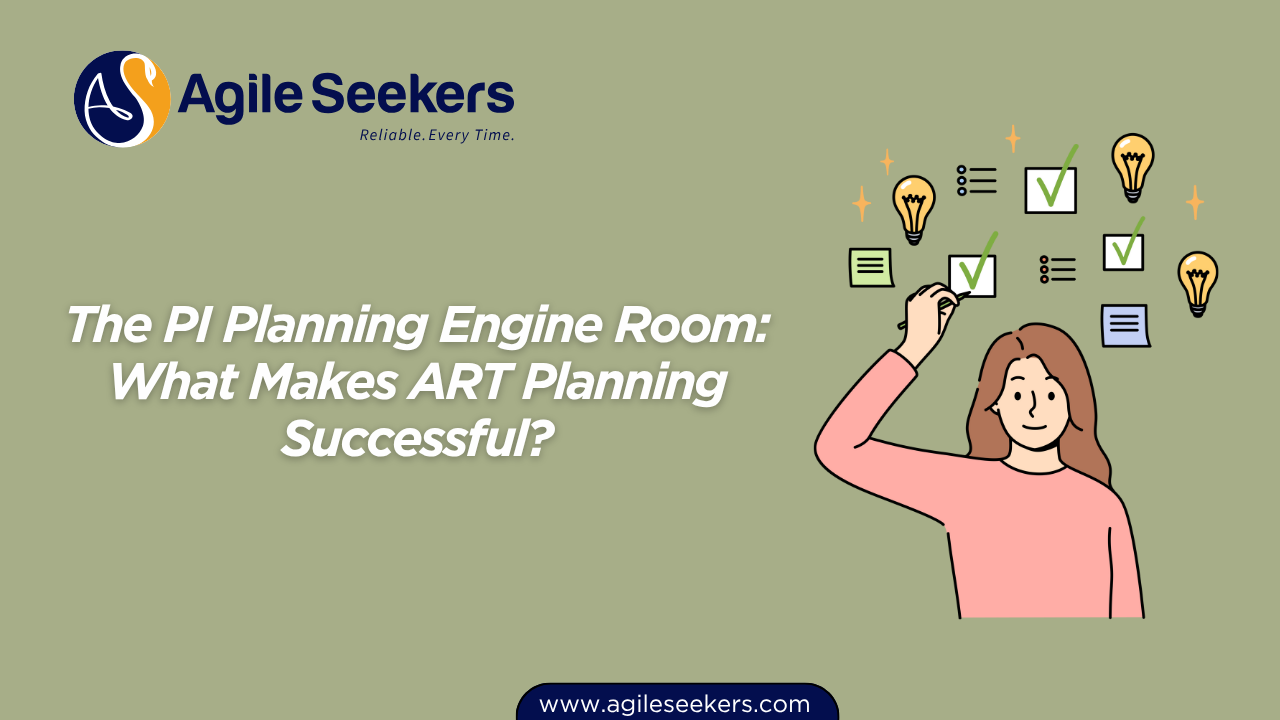The PI Planning Engine Room: What Makes ART Planning Successful?

Program Increment (PI) Planning is the heartbeat of the Agile Release Train (ART). It’s not just a two-day event—it’s the foundation of alignment, commitment, and collaboration across teams. When done right, PI Planning transforms strategic intent into a synchronized plan of action. But what truly powers successful ART planning? Let’s step inside the engine room and break it down.
1. Clear and Aligned Business Context
PI Planning kicks off with a shared understanding of the business context and vision. Leaders must present a compelling narrative—not just what the goals are, but why they matter. This enables teams to plan features and dependencies that deliver value, not just output.
The Release Train Engineer (RTE) ensures that product management, business owners, and architects are prepared with this vision. This clarity aligns teams on a common direction and eliminates ambiguity during breakout sessions.
A well-prepared PI Planning event reflects leadership alignment—something deeply covered in the Leading SAFe Certification training.
2. Prepared Backlogs, Not Just User Stories
ART Planning fails when backlogs are vague or last-minute. High-performing ARTs invest in backlog refinement well ahead of the PI event. Features must be prioritized, elaborated, and sized to a level that team members can confidently break them into Iteration plans.
The Product Owner/Product Manager (POPM) role is critical here. POPMs collaborate with architects and stakeholders to ensure backlog items are aligned to objectives and include acceptance criteria.
Learn how to prepare and manage PI-ready backlogs through the SAFe Product Owner/Product Manager POPM Certification.
3. Collaborative Planning, Not Command-Control
The essence of Agile is autonomy with alignment. During breakout sessions, ART teams self-organize around the work. Rather than handing down plans, leadership creates a space for collaborative exploration.
This fosters team ownership. Each team identifies risks, commits to objectives, and works through cross-team dependencies. The role of the SAFe Scrum Master becomes crucial—they facilitate team breakouts, manage timeboxes, and escalate impediments early.
Get deeper insights into this facilitative leadership through the SAFe Scrum Master Certification.
4. Visualizing and Managing Dependencies
Dependencies across teams can derail even the most refined plans if left unchecked. A robust dependency mapping process, using tools like the Program Board, helps ARTs visualize feature flows and delivery bottlenecks.
Architects, Scrum Masters, and Product Managers work together to sequence features and stories to minimize delays and optimize throughput. Risk ROAMing (Resolve, Own, Accept, Mitigate) becomes a powerful tool here.
The SAFe Advanced Scrum Master training sharpens skills in handling these multi-team planning dynamics and system-level impediments.
Build deeper coordination skills with the SAFe Advanced Scrum Master Certification.
5. Business Owners Actively Engage
Success doesn’t come from passive sign-offs. Business Owners must actively participate throughout the planning cycle—not just to approve but to provide real-time feedback and negotiate priorities.
They attend team breakouts, challenge assumptions, and validate business value during draft and final plan reviews. This makes commitment more than ceremonial; it’s a mutual agreement grounded in context and data.
SAFe emphasizes this feedback loop extensively in the Leading SAFe Agilist training, encouraging leadership that’s present and adaptive.
6. Decentralized Planning, Centralized Alignment
Each team builds its own plan, but synchronization is key. The ART Sync and confidence vote surface misalignments and allow adjustments on the fly. Shared tools like digital Program Boards (e.g., Miro, Jira Align) help manage remote participation and time zones.
This is where the Release Train Engineer becomes a conductor—ensuring momentum, handling escalations, and preserving the cadence of events.
To master the orchestration of PI Planning across large ARTs, explore the SAFe Release Train Engineer Certification.
7. Measurable Objectives and Confidence Voting
Each team creates SMART PI Objectives—not task lists, but business outcomes. These are presented to Business Owners who assign business value, creating alignment on expectations.
The confidence vote is a final pulse check. If the plan lacks support, ARTs collaborate to make necessary adjustments. This ensures shared accountability, not blind optimism.
Understanding how to derive business value through PI Objectives is a core element of the POPM Certification.
8. Inspect, Adapt, and Improve Every PI
PI Planning success isn’t just in the plan—it’s in how teams reflect and improve. Each ART ends the PI with an Inspect and Adapt workshop, reviewing the outcomes, system demo results, and systemic issues.
Teams identify what worked, what didn’t, and what must change. This continuous improvement mindset elevates every subsequent PI Planning session.
The iterative learning loop—plan, execute, inspect—is championed across SAFe roles, including in Scrum Master and Advanced Scrum Master certifications.
9. Empowered Roles, Not Silos
The ART is only as strong as the collaboration between roles. RTEs, Scrum Masters, POPMs, Architects, and Business Owners must operate as a tight-knit leadership coalition, not isolated experts.
Their alignment sets the tone for the ART’s performance. When this leadership group communicates openly and frequently before and during PI Planning, the event runs smoothly—and the train delivers predictably.
10. Leverage Technology to Remove Friction
Whether co-located or distributed, modern ARTs rely on virtual whiteboards, integrated backlogs, and real-time planning boards. Tools like Jira Align, Miro, and SAFe Studio remove coordination friction and enhance visibility across stakeholders.
Technology is not the solution—but it is an enabler. The real driver is human alignment supported by digital clarity.
Final Thoughts
PI Planning isn’t just a SAFe ritual. It’s the engine room where alignment becomes action, strategy becomes backlog, and collaboration becomes commitment. When the right roles show up prepared, with a clear backlog, strong facilitation, and business engagement, ART Planning transforms delivery.
Every successful ART thrives on this foundation. And if you're looking to build that expertise—whether you're a Scrum Master, Product Owner, or aspiring RTE—SAFe’s certification paths offer the structure and insights you need to lead with impact.
Also read - How System Demos Drive Alignment and Quality
Also see - Understanding ART Sync




















